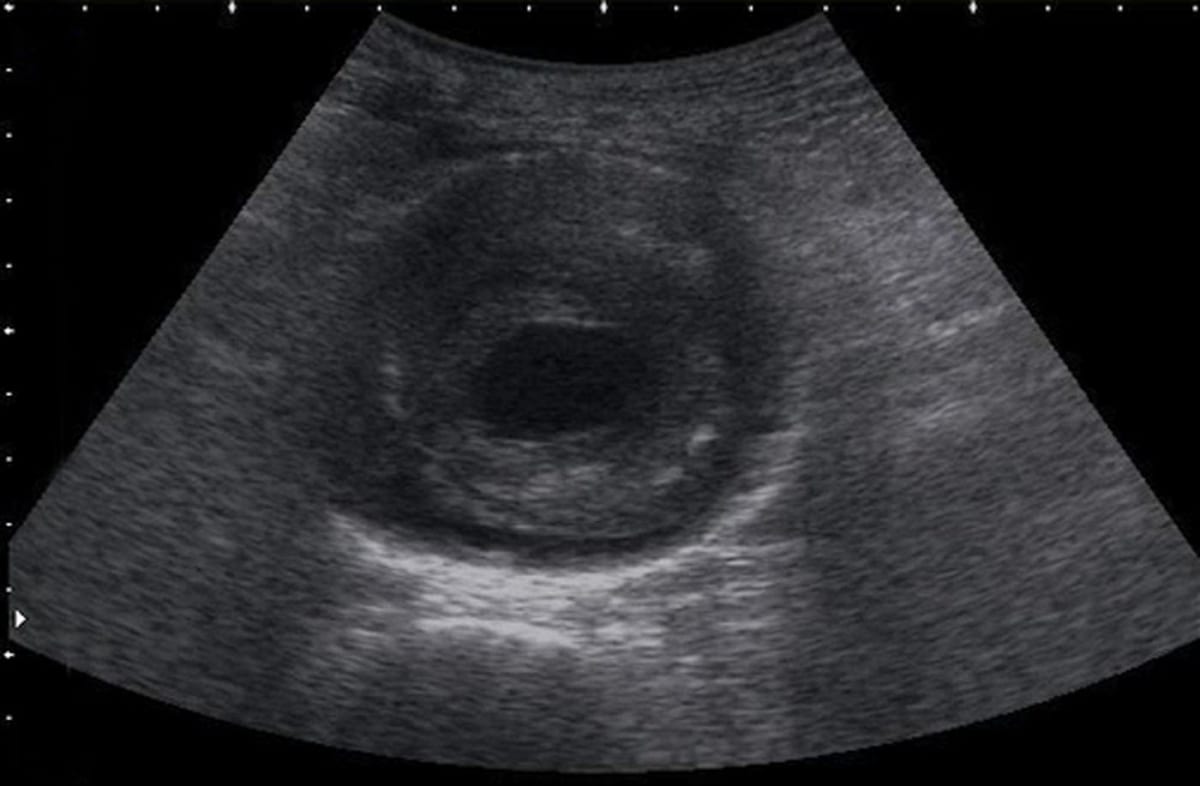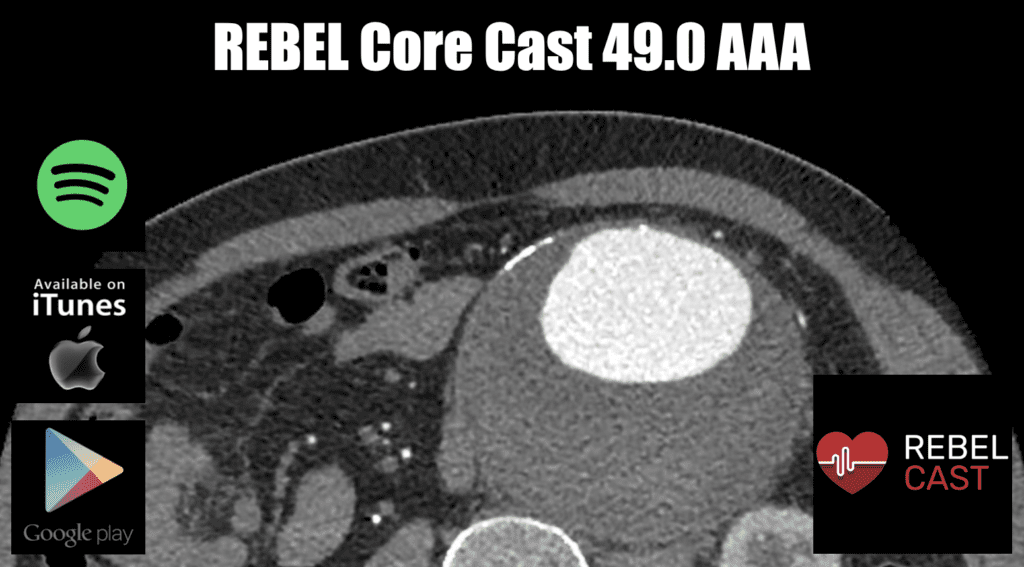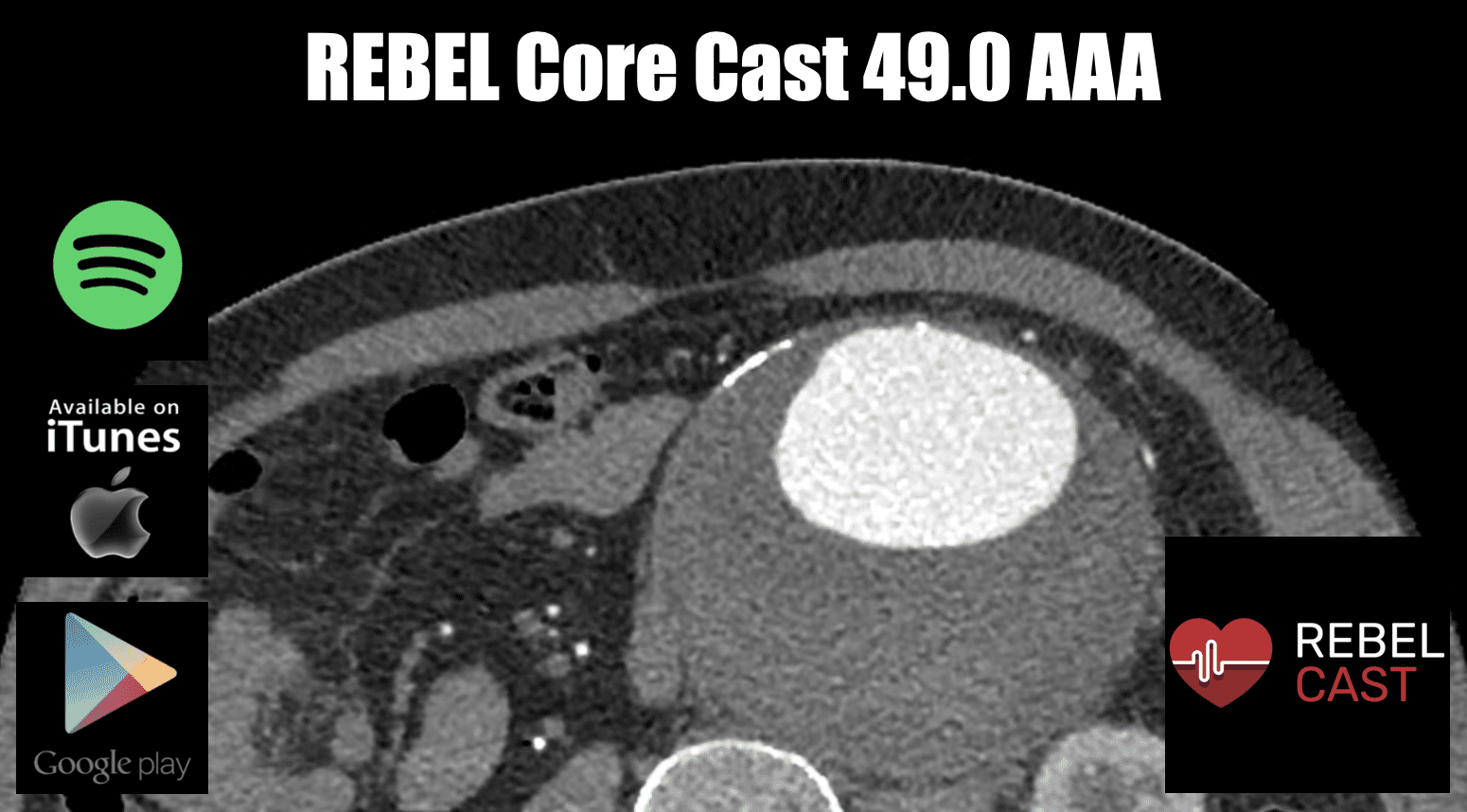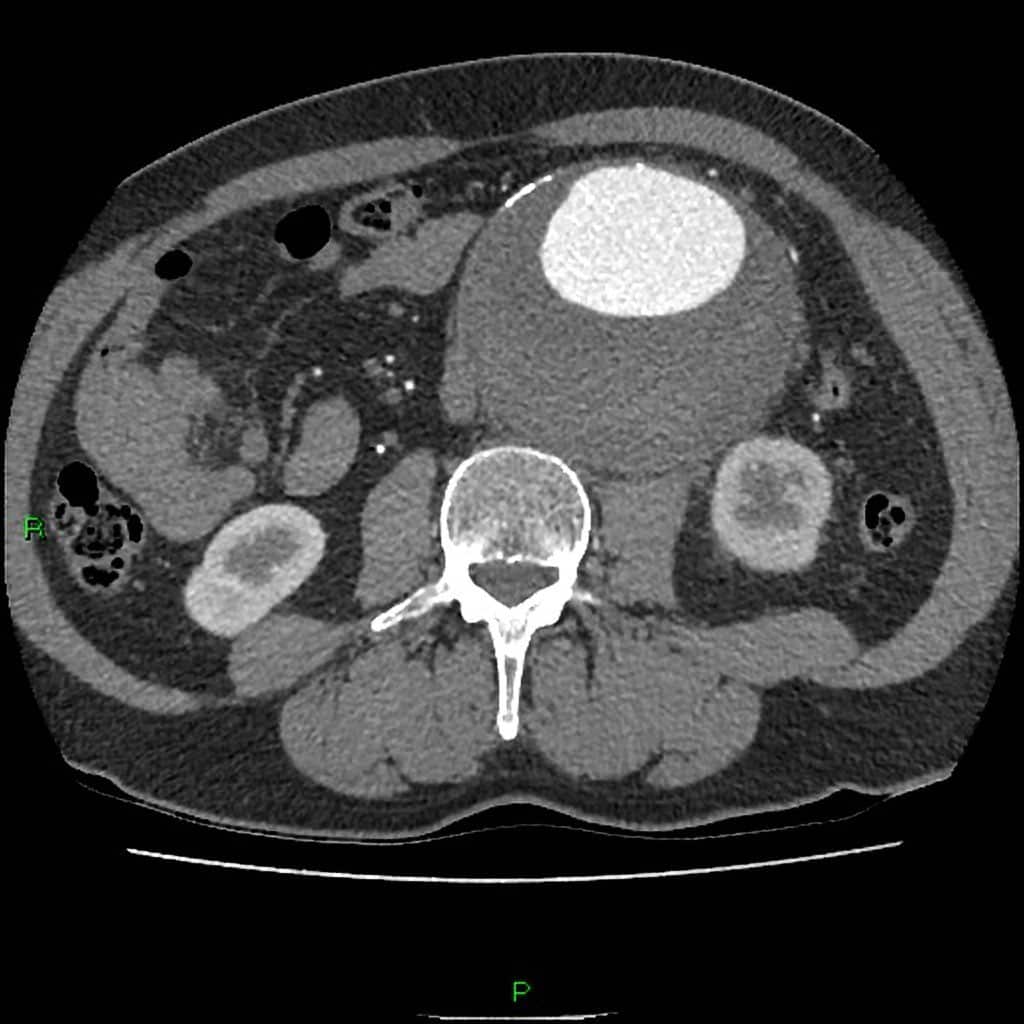- Consider ruptured AAA in patients (especially those > 50 years of age) with unexplained hypotension, back or abdominal pain
- All ruptured AAAs should be considered unstable regardless of vital signs as rapid deterioration is common
- A ruptured AAA is 100% fatal without surgical or endovascular intervention. Mobilize your surgical colleagues early
REBEL Core Cast 49.0 – Abdominal Aortic Aneurysm
Definition: An abdominal aortic aneurysm (AAA) is localized dilation (> 3 cm) of the aorta caused by a weakening involving all three layers (intima, media and adventitia) of the aortic wall. It most commonly develops distal to the renal arteries.
Epidemiology:
- Uncommon in patients < 50 yo
- Found in 2-5% of men > 50 yo
- It is more common:
- In men than women
- In patients with coronary artery disease (CAD) or peripheral arterial disease (PAD)
- Patients with a family history of AAA
- Smokers
- Up to 50% of AAA in patients < 65 occur in women
- Mortality
- 30-40% with open aortic repair
- 20-25% with endovascular repair
- Normal infrarenal aorta < 2 cm in diameter. Infrarenal aorta > 3 cm is considered to be aneurysmal.
- Most ruptures occur in aortas > 5 cm in diameter
Presentation
Unruptured Aneurysm
- Signs and Symptoms
- Most AAAs are asymptomatic until expansion or rupture occurs
- Pain is a common symptom when symptoms are present
- Abdominal, back and/or flank pain
- Acute pain associated with a AAA can mimic renal colic
- Acute pain may be an ominous sign of impending rupture
- Physical Exam
- Large aneurysms may be found on routine abdominal examination as pulsatile abdominal masses
- May be limited secondary to patient body habitus and size of aneurysm
- Abdominal bruits are uncommon findings
- Complications of unruptured AAAs
- Thromboembolic: lower extremity ischemia
- Direct compression of adjacent structures (duodenum, ureters etc)
Ruptured Aneurysm
- Classic Triad: Pain, hypotension and a pulsatile abdominal mass. Often will only see one or two features of the triad
- Symptoms
- Pain is the most common symptom
- Abdominal, back and/or flank
- Typically acute in onset, severe and can radiate to the chest, back or groin
- Acute onset of pain in a patient with a AAA should be assumed to be secondary to rupture
- Syncope (or near-syncope) is common though hemodynamic compensation may result in near-normalization of blood pressure
- Pain is the most common symptom
- Physical Exam
- Large, palpable abdominal mass
- Aortic pulsation may be felt (may be absent if blood pressure is low)
- Hypotension
- Seen in 50% of ruptures on presentation (Gaughan 2009, Rose 2001)
- Late finding suggestive of impending hemodynamic collapse and death
- Tachycardia may be variably present
- Many patients are on beta-blockers at baseline
- Blood in the abdomen can stimulate vagal responses leading to lower than expected heart rate
- AAA Variants
- Aortoenteric fistula
- Definition: AAA rupture into the GI tract that can be either primary (from an unrepaired AAA) or secondary (after prior aortic repair)
- Consider diagnosis in any patient with a known AAA or prior repair who presents with GI bleeding
- Can see both hematemesis and melena as the aortoenteric fistula commonly connects the AAA to the duodenum
- Patients will typically experience rapid, massive exsanguination. Aortoenteric fistula has a very high morbidity and mortality
- Aortocaval fistula
- Definition: Periaortic inflammation leads to a connection between the AAA and the adjacent vena cava.
- Free rupture of the AAA will present in same way as any ruptured AAA
- Formation of a large arteriovenous (AV) fistula may occur if there is no external AAA leak
- Signs and Symptoms (Cinara 2005)
- Palpable mass (80-90%)
- Abdominal bruit (75%)
- Palpable thrill (25%)
- Aortoenteric fistula
Differential Diagnosis
- Aortic Dissection
- Ureteric Colic
- Pancreatitis
- Intestinal ischemia
- Bowel obstruction
- Diverticulitis

Diagnostics
- Patients with ruptured aneurysms will often be diagnosed based on clinical presentation alone.
- Ultrasound
- Sensitivity for detecting AAA approaches 100% (Lederle 2003)
- Detection of AAA rupture
- Presence of free intraperitoneal fluid confirms rupture
- Rupture may be retroperitoneal or small leading to a false negative US for free fluid
- Advantages
- Allows for rapid evaluation of the aorta as a cause for shock in the undifferentiated patient while resuscitation is ongoing
- Obviates the need for the patient to be transported to the radiology department for imaging
- Can provide alternative explanations for the patient’s presentation
- Limitations
- Prone to both technical (ultrasonographer skills) and interpretive error
- Visualization of the aorta can be limited by obesity or the presence of bowel gas
- Not as sensitive for detecting rupture
- CT Scan
- Abdominal CT has a sensitivity and specificity approaching 100% for both diagnosis of AAA as well as rupture (Hermsen 2004)
- Addition of IV contrast can delineate the patent lumen of the AAA from the mural thrombus but is not necessary for identification of aneurysm or hemorrhage
- More sensitive than US for detecting retroperitoneal hemorrhage of AAA
- CT also helpful in identifying alternative diagnoses
Management
Regardless of vital signs, patients with ruptured AAA should be considered unstable and should be aggressively resuscitated. A ruptured AAA has a mortality rate > 80%. (Adam 1999)
Basics: ABCs, Large bore (> 16 gauge) IV X 2, Supplemental O2 (if needed), Cardiac
Monitor + Immediate Surgical Consultation for repair
Aggressive Volume Resuscitation in Hypotensive patients
- Target systolic blood pressure of 90-100 mm Hg pre-operatively
- Exact target unknown
- Over-resuscitation may contribute to increased bleeding from dilutional coagulopathy
- Under-resuscitation harmful as prolonged hypotension can lead to end-organ damage (myocardial infarction, renal failure) and cardiac arrest
- Start with administration of uncrossmatched blood
- Activate massive transfusion protocol as patients often have large transfusion requirements
- Consider administration of a 1:1:1 (PRBC:FFP:Platelets) ratio of blood products
- Administer reversal agents for anticoagulant use if indicated
Take Home Points
- Consider ruptured AAA in patients (especially those > 50 years of age) with unexplained hypotension, back or abdominal pain
- All ruptured AAAs should be considered unstable regardless of vital signs as rapid deterioration is common
- A ruptured AAA is 100% fatal without surgical or endovascular intervention. Mobilize your surgical colleagues early
Read More
- CorePendium: Abdominal Aortic Aneurysm
- EM Cases: Best Case Ever 43 Ruptured Aortic Aneurysm
References
- Adam DJ et al. Community and hospital outcome from ruptured abdominal aortic aneurysm within the catchment area of a regional vascular surgical service. J Vasc Surg 1999; 30:922-928. PMID: 10550191
- Cinara IS et al: Aorto-caval fistulas: A review of eighteen years experience. Acta Chir Belg 2005; 105:616-620. PMID: 16438071
- Gaughan M et al. Emergency abdominal aortic aneurysm presenting without haemodynamic shock is associated with misdiagnosis and delay in appropriate clinical management. Emerg Med J 2009; 26:334-339. PMID: 19386866
- Hermsen K, Chong WK. Ultrasound evaluation of abdominal aortic and iliac aneurysms and mesenteric ischemia. Radiol Clin North Am 2004; 42:365-381. PMID: 15136022
- Lederle FA: Ultrasonographic screening for abdominal aortic aneurysms. Ann Intern Med 2003; 139:516-522. PMID: 24957320
- Rose J et al. Ruptured abdominal aortic aneurysms: Clinical presentation in Auckland 1993-1997 ANZ J Surg 2001; 71: 341-4. PMID: 11409018
Post Peer Reviewed By: Salim R. Rezaie, MD (Twitter: @srrezaie)
Cite this article as: Anand Swaminathan, "REBEL Core Cast 49.0 – Abdominal Aortic Aneurysm (AAA)", REBEL EM blog, February 10, 2021. Available at: https://rebelem.com/rebel-core-cast-49-0-abdominal-aortic-aneurysm-aaa/.







